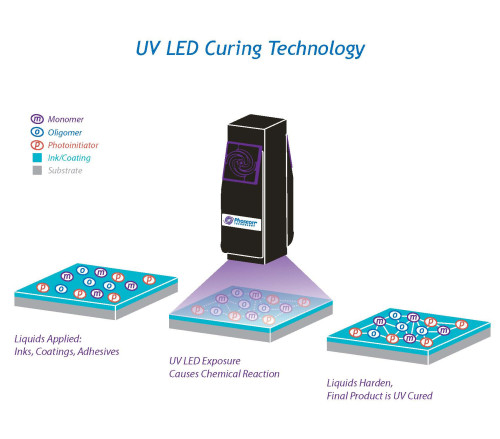Manufacturing printers
In 2008, Roland DGA’s VersaUV LEC series was reportedly the world’s first line of UV-curing inkjet printer/cutters to use low-heat LED lamps that would last up to 10,000 hours and enable printing on heat-sensitive media like paper stocks and shrink wrap.
“We’ve printed everything from small candy pouches on foils to point-of-purchase (POP) displays on solid bleached sulfate (SBS) board, all with great results,” says Rob Torres, director of digital media for White Graphics in Downers Grove, Ill.
In 2011, Electronics for Imaging (EFI) integrated UV LEDs in its 3.2-m (10.5-ft) wide Vutek GS3250LX digital inkjet printer to enable output on a wider media mix and for an extended range of applications, with less warping than with traditional UV curing, and at a low total cost of ownership (TCO).
 “UV LED lamps provide unique capabilities we could not have delivered to our customers with traditional mercury-based lamps,” said Ken Hanulec, EFI’s vice-president (VP) of marketing for inkjet systems.
“UV LED lamps provide unique capabilities we could not have delivered to our customers with traditional mercury-based lamps,” said Ken Hanulec, EFI’s vice-president (VP) of marketing for inkjet systems.
Energy assessments carried out by Fogra, a graphic technology research association, have found EFI’s Vutek printers with UV LEDs reduce energy use by up to 82 per cent when compared to printers using conventional mercury arc lamps. Even in print-ready mode, for example, the LEDs save up to 77 per cent in electricity use because they are turned off when the machine is idle between jobs, where mercury arc lamps would continue to consume power.
Durst Phototechnik introduced UV LEDs with its Omega 2 inkjet flatbed and roll-to-roll (R2R) printer, designed to allow graphic designers, signmakers and photo labs to print on a broader range of materials, including rigid aluminum composites, wooden panels, acrylics, polyvinyl chloride (PVC), paper, fabrics, polycarbonates and metals.
Mimaki developed new inkjet printheads, inks and UV LEDs for its JFX500-2131 grand-format printer in 2012. In addition to reducing power consumption compared to arc lamps, the LEDs were optimized to ensure no ink would be left uncured.
Fujifilm North America’s graphic systems division also adopted the technology in 2012 for the Acuity LED 1600 UV inkjet printer, engineering a patented full LED lamp system specifically to cure its Uvijet inks in a two-stage process. Small, low-dose LED ‘pinning’ lamps close to the printhead hold an ink drop in place while the main lamps fully cure the print. Adjustable lamp positioning also enables curing to be finely controlled.
In 2013, Barberán in Barcelona, Spain, introduced the Jetmaster-1260, a digital inkjet printer with UV LED curing designed for the single-pass printing of boards. Thanks to the LEDs’ compatibility with heat-sensitive substrates, the Jetmaster prints simulated wood grain texture patterns on a wide variety of materials, including cardboard, melamine, paper, particle board, medium-density fibreboard (MDF), high-density fibreboard (HDF) and texture-free wood. Printed at more than 1,400 dots per inch (dpi), the resulting ‘graphics’ feel like real wood grain to the touch. Applications of the technology include interior décor, foil-based wraps, decoration and architectural finishes.





